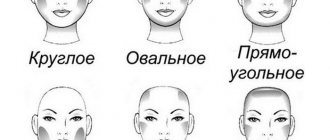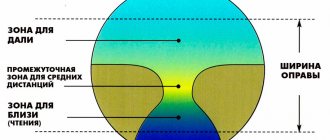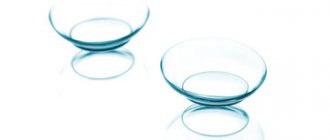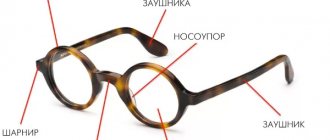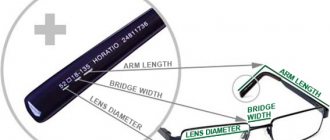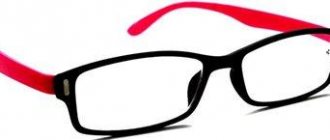A large number of vision problems in adults are the result of untimely access to an ophthalmologist in childhood, and the advanced state of the disease at the time of treatment. In childhood, a correct perception of the world is formed at the level of the brain; visual acuity is established in the first 10 years of life; this is not an innate given. With timely correction, complete restoration of vision is possible.
Children's glasses: how to choose, types of frames and lenses
Important : All measures to improve vision are carried out against the background of the use of glasses - in childhood, the picture in the brain must be clear, standard, in order to create a model of not only perception, but also the “tuning” of the parts of the eye.
Our tips will help:
a) find out what glasses your child is ready to wear
b) reduce the time spent in the optical salon when choosing glasses for your child
Most children who are prescribed glasses are either nearsighted or farsighted. Depending on this, the ophthalmologist will write a prescription for glasses, which will need to be worn full or part time. As a rule, the doctor gives some recommendations on the selection of glasses, but the decision still remains with the parents, children and the optical consultant, who helps choose frames in the optical salon.
So: here are a few points that will make your trip to the children's optics salon a positive one and help you buy glasses that your child will be happy to wear!
Svetlana, 9 years old, Perevoz (Nizhny Novgorod region)
How to choose lenses and frames for children's glasses: answers to the most important questions
The number of children with certain visual impairments is growing every year. It is possible to prevent the development of serious pathologies or significantly facilitate a child’s “view of the world” with the help of comprehensive treatment. It is important to choose high-quality and safe optics in accordance with the recommendations of a specialist.
Our conversation today will be about the following:
1) How to choose glasses and frames for a child? Features of titanium, plastic, silicone frames. 2) How to teach a child to wear glasses? 3) What is the danger of lack of correction?
So, let's start with the main thing. How to choose the right glasses for a child? Let us immediately clarify that optical aids are a correction, and not a method of treating ophthalmological diseases! Glasses provide good and stable vision to a child with various impairments.
For parents whose child has been examined by an ophthalmologist and is forced to wear optics for medical reasons, it is important to understand which glasses to choose? Do I need to wear optics all the time?
We answer.
Currently, there are two main ways to select spectacle lenses for children.
Some experts believe that it is necessary to compensate for visual defects completely. In this case, glasses with an optical power equal to the visual deviation are selected. For example, with a −3D indicator in a small patient, the lenses should be equipped with the same set of diopters.
According to other experts, the optimal optics for children is one diopter less than the actual deviation. In this way, the accommodative apparatus is stimulated. In general, ophthalmologists agree that if the Patient has a high degree of myopia or farsightedness, the lack of optimal correction can only do harm.
During a comprehensive examination, the ophthalmologist usually prescribes several studies, including autorefractometry, checking visual acuity using tables, examining the fundus with an ophthalmoscope, etc. The information obtained will allow us to determine the optical power of spectacle lenses recommended for wearing in the prescribed mode. A child with severe forms of myopia, hyperopia and astigmatism needs to wear glasses all the time. When you reach the age of majority, that is, 18 years old, you can sign up for laser correction.
How to choose a frame for glasses?
Here everything depends solely on the parents. A specialist can give some recommendations, but you need to choose the material, shape, size and other important characteristics with the child. After all, he is the one who wears glasses! For maximum comfort and freedom from constraint, it is important to select the optics according to size. Glasses should not fall off your face, rub your ears, or put pressure on the bridge of your nose. Another point is the lightness of the optics. Modern glasses presented on the product market meet this requirement. They can be made of metal, plastic, silicone and more expensive raw materials, which we, perhaps, will not consider.
Unlike other metals, titanium is very light and is particularly hypoallergenic. True, such frames also have a significant drawback - a rather high price. Considering that children often lose or break glasses, such a waste of money may not be justified. But it's up to the parents to decide!
Plastic frames are inexpensive, characterized by relative strength, heat resistance, lightness, and a wide selection of shapes, colors and shades.
By the way, “plastic” refers to many different polymers: cellulose acetate, grilamid, from which the lightest glasses are made.
Silicone frames are the choice of most parents. Glasses with such frames are particularly safe, reliable, lightweight and have a long service life. In addition, silicone frames can be bent in different directions and are very difficult to break. Spectacle optics models are made from hypoallergenic, non-toxic materials. There are no metal inserts in them. Another undeniable advantage of silicone models is hydrophobicity, that is, water repulsion. In glasses with silicone frames you can jump, run, and play sports. Such correction tools would be ideal, if not for one BUT: they are often not very aesthetic.
A few words about glasses lenses
Today, plastic lenses are very popular. Glass ones are not very safe and comfortable to wear. Plastic lenses do not break when dropped or hit and are not capable of injuring a child. The products are particularly durable - polycarbonate is almost as good as aluminum, the material heats up little in the sun, and the cost of such lenses is very affordable. True, polycarbonate lenses have their drawbacks: they are “weak” to external influences (meaning scratches and other damage), so after some time (usually six months or a year) they require replacement. Preschoolers and primary schoolchildren have to buy glasses even more often.
We sorted out the lenses and frames.
But how do you teach a child to wear glasses?
First of all, you should focus on the child’s taste - if he likes the frames, then he will wear the glasses without difficulty and with pleasure. Secondly, draw your son or daughter’s attention to adult relatives, friends or favorite cartoon characters who wear glasses. Accustom him to glasses gradually and constantly tell him how they suit him. Children especially love praise. Upon reaching a certain age (usually 10-12 years, sometimes earlier, and sometimes later), glasses can be replaced with contact lenses. A middle school student will be able to properly wear, remove and care for such correction devices. It is necessary to consult with an ophthalmologist, undergo a comprehensive examination and select the optimal products.
Is lack of correction dangerous?
A child’s eyes usually “grow” with him until he is 12-14 years old. Throughout time, the basic functions of vision are formed, including binocularity - the ability to see the world in 3D format. If optics are not selected and worn in a timely manner, the child may develop strabismus: divergent in case of myopia, and convergent in case of farsightedness.
Wearing properly selected optical products makes it possible to prevent an increase in the degree of ophthalmic disease and a number of other serious ailments.
The Lornet network of optical salons offers you a consultation with a pediatric ophthalmologist and purchases the optimal vision correction products. In our stores you will find competent employees, a wide selection of glasses and frames for children from famous brands (Fisher Price, Hello Kitty, Nano and many others) at competitive prices!
Fashion. Yes, yes, fashion...
Whether glasses are used all the time or your child wears them occasionally, they may get a little teasing, especially the first time they wear glasses around. Do you want your child’s friends to say “cool”, “super”...? Then give him the opportunity to participate in choosing glasses himself. Modern children's optics stores can offer you a lot of different options - from classic glasses shapes to the most unusual ones. Consultants will always tell you what glasses are in fashion now, but keep in mind: if you buy unusual glasses for your child, there is a high probability that their use will be limited and you will soon have to visit the optical store again.
Treatment glasses and other recommendations
How to choose the right medical glasses? The above describes, perhaps, the main rules when choosing sunglasses. But sometimes children have to wear medical glasses to improve their vision. It is clear that the main criterion is that the diopters in the purchased glasses correspond to those prescribed by the doctor. What else is needed for a child to feel comfortable wearing glasses and not feel the constant desire to hide them away?
It should be remembered that vision in children changes quite quickly, and under the influence of wearing glasses, it can be restored, so visual acuity should be checked 1-2 times a year, and glasses should be replaced if necessary. If wearing glasses causes eye fatigue, watery eyes, redness, or pain, be sure to consult an ophthalmologist.
Plastic frames vs metal frames
Children's glasses can be either plastic or metal. Today many are for children's frames. These glasses will make your child look more mature. But children, most often, are not frightened by this, but on the contrary, they are interested - they love to be like mom or dad! In terms of material, plastic is the best choice for children, glasses made of plastic are considered more durable, plastic frames are less likely to be bent or broken, they are lighter in weight and cheaper.
With the advent of TitanFlex material, manufacturers began to make metal frames that are functionally no different from plastic ones. True, this is reflected in the cost of glasses. Pay attention to such a factor as hypoallergenicity, especially if your child is sensitive to any materials.
Geometry rule
To select the right frame, you must remember that the shape of the frame should complement and balance the shape of your face.
- If you have a rectangular or square face, rounded frames are the best option. And, conversely, frames with clear geometric shapes look good on round and oval faces.
- In the case of a pear-shaped face, it will be perfectly balanced by a frame that has a wider and more massive upper part.
- A heart-shaped face will be decorated with frames that have a slight extension towards the bottom.
The bridge of the frame may seem like an insignificant element, but it determines how people perceive the eyes and nose. For example, a thin bridge can create the appearance of wide-set eyes. With a wide bridge, the eyes appear to be set close. And the low bridge visually makes the nose shorter.
We sit on the bow, looking far away
One of the most important points when choosing glasses for children is the correct fit of the glasses on the nose. It is necessary to choose the frame so that it does not slide down the small nose of your treasure. Metal frames are usually made with an adjustable nose pad, so they fit everyone. Most plastic frame manufacturers recognize this difficulty and create frames that fit even the smallest noses. Here you should look very carefully at how different glasses fit on your child’s nose, and the salon’s optical consultant will help you with this.
Lens material
Once you and your child have decided on a frame, you should choose lenses. Everyone knows that children cannot sit still all the time: they run, play and often fall... Therefore, lenses for children's glasses should be made of polycarbonate, this is the most impact-resistant material. In addition to being a safe material, it is also lighter in weight than regular plastic. Polycarbonate has built-in protection from potentially harmful UV rays and these lenses are scratch resistant. With polycarbonate lenses, children receive an additional margin of strength and protection for their eyes. The least desirable material for your child's lenses is glass. Remember - even the safest glass is a danger to your child's eyes, and glass lenses are heavier, which makes them less comfortable.
